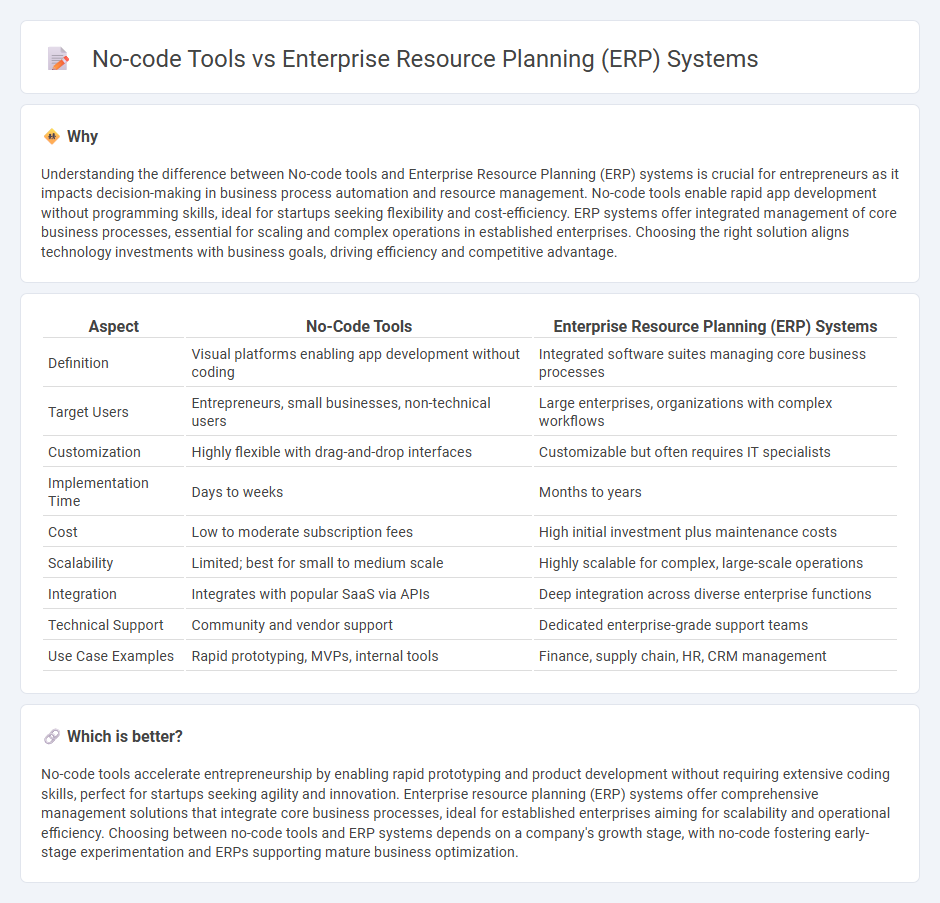
No-code tools empower entrepreneurs to rapidly develop customized applications without extensive programming knowledge, enhancing agility and innovation in business operations. Enterprise Resource Planning (ERP) systems offer comprehensive, integrated software solutions that streamline core business processes such as finance, supply chain, and human resources within established enterprises. Explore how leveraging no-code tools and ERP systems can accelerate business growth and operational efficiency.
Why it is important
Understanding the difference between No-code tools and Enterprise Resource Planning (ERP) systems is crucial for entrepreneurs as it impacts decision-making in business process automation and resource management. No-code tools enable rapid app development without programming skills, ideal for startups seeking flexibility and cost-efficiency. ERP systems offer integrated management of core business processes, essential for scaling and complex operations in established enterprises. Choosing the right solution aligns technology investments with business goals, driving efficiency and competitive advantage.
Comparison Table
| Aspect | No-Code Tools | Enterprise Resource Planning (ERP) Systems |
|---|---|---|
| Definition | Visual platforms enabling app development without coding | Integrated software suites managing core business processes |
| Target Users | Entrepreneurs, small businesses, non-technical users | Large enterprises, organizations with complex workflows |
| Customization | Highly flexible with drag-and-drop interfaces | Customizable but often requires IT specialists |
| Implementation Time | Days to weeks | Months to years |
| Cost | Low to moderate subscription fees | High initial investment plus maintenance costs |
| Scalability | Limited; best for small to medium scale | Highly scalable for complex, large-scale operations |
| Integration | Integrates with popular SaaS via APIs | Deep integration across diverse enterprise functions |
| Technical Support | Community and vendor support | Dedicated enterprise-grade support teams |
| Use Case Examples | Rapid prototyping, MVPs, internal tools | Finance, supply chain, HR, CRM management |
Which is better?
No-code tools accelerate entrepreneurship by enabling rapid prototyping and product development without requiring extensive coding skills, perfect for startups seeking agility and innovation. Enterprise resource planning (ERP) systems offer comprehensive management solutions that integrate core business processes, ideal for established enterprises aiming for scalability and operational efficiency. Choosing between no-code tools and ERP systems depends on a company's growth stage, with no-code fostering early-stage experimentation and ERPs supporting mature business optimization.
Connection
No-code tools enhance Entrepreneurship by enabling rapid customization and integration of Enterprise Resource Planning (ERP) systems without requiring extensive programming skills. This connection streamlines business processes, improves data management, and accelerates decision-making for startups and small businesses. Leveraging no-code platforms with ERP systems reduces implementation costs and fosters agility in adapting to market demands.
Key Terms
Integration
ERP systems offer robust integration with core business functions such as finance, supply chain, and human resources, enabling seamless data flow across departments through standardized APIs and middleware. No-code tools provide flexible integration options tailored for non-technical users, often supporting popular third-party applications via drag-and-drop connectors and pre-built templates. Explore how choosing between ERP systems and no-code platforms can transform your organization's operational efficiency through optimized integration.
Customization
Enterprise resource planning (ERP) systems offer deep customization through extensive coding, allowing businesses to tailor processes, workflows, and reports to specific industry needs. No-code tools provide customization via user-friendly drag-and-drop interfaces and pre-built modules, enabling rapid adjustments without technical expertise. Explore how selecting the right customization approach boosts operational efficiency and scalability.
Scalability
Enterprise resource planning (ERP) systems generally offer superior scalability, supporting complex workflows and large volumes of data across multiple departments and global locations. No-code tools excel in rapid application development with ease of customization but may face limitations when scaling to enterprise-level requirements such as advanced integrations and high user concurrency. Explore further to understand which solution best fits your organization's scalability needs.
Source and External Links
Enterprise resource planning - Wikipedia - ERP is integrated management software for main business processes, tracking resources and commitments, providing a continuously updated, shared view of core functions like manufacturing, sales, and payroll, often cloud-based for accessibility.
What is Enterprise Resource Planning (ERP)? - IBM - ERP software manages and streamlines all parts of a business such as finance, HR, manufacturing, and supply chain through connected modules sharing a common database, eliminating data silos and improving workflow automation.
What is ERP? A Comprehensive Guide - NetSuite - ERP automates business processes and centralizes data from departments like accounting, sales, and HR into a single system that enhances analysis, internal controls, and cross-departmental visibility, driving efficiency and cost savings.
 dowidth.com
dowidth.com